As a commuter, you've got plenty of sustainable options to consider. Electric bikes let you dodge traffic and tackle hills with ease. Public transportation keeps emissions low and reduces congestion. Carpooling's a smart choice for saving money and meeting new people. If you prefer flexibility, e-scooters offer quick, emission-free rides. Walking is the most eco-friendly way to go. Each option has its benefits, and there's more to explore about green commuting alternatives.
Key Takeaways
- Electric bikes offer an eco-friendly commuting solution, reducing carbon footprints and making steep hill climbs easier.
- Public transportation enhances efficiency, reduces traffic congestion, and incorporates eco-friendly technologies for sustainable travel.
- Carpooling minimizes emissions and fuel consumption while fostering social interactions among commuters.
- Walking is the most environmentally friendly option, promoting physical health and reducing air pollution.
- E-scooters provide a quick, zero-emission alternative for short urban trips, easily accessible via smartphone apps.
Electric Bikes: The Future of Urban Commuting

As urban areas become increasingly congested, electric bikes are emerging as a practical solution for your daily commutes.
With their ability to zip through traffic and access bike lanes, e-bikes let you bypass the frustrations of gridlock. You'll enjoy the fresh air while reducing your carbon footprint, making them an eco-friendly choice.
Plus, they offer a convenient way to tackle those steep hills without breaking a sweat. Charging is simple, and many models can fold for easy storage or transport.
Whether you're heading to work or running errands, an electric bike can save you time and money on fuel and parking.
Embrace the future of urban commuting and experience the freedom that comes with riding an e-bike.
Public Transportation: Efficiency Meets Sustainability

Electric bikes are just one piece of the puzzle when it comes to sustainable commuting.
Public transportation plays a crucial role in reducing your carbon footprint. By choosing buses, trains, or trams, you're not only cutting down on personal vehicle emissions but also supporting a system designed for efficiency.
Public transportation significantly lowers your carbon footprint while promoting an efficient and eco-friendly commuting system.
Public transit reduces traffic congestion, saving you time and stress during your daily commute. Plus, these systems are increasingly adopting eco-friendly technologies, including electric and hybrid vehicles, making them even more sustainable.
You'll find that many cities are improving their transit infrastructure, offering more routes and reliable schedules.
Carpooling: Sharing Rides, Reducing Emissions

While many commuters rely on solo drives, carpooling offers a smarter way to reduce emissions and ease traffic congestion. By sharing rides with colleagues or neighbors, you not only cut down on fuel consumption but also save on parking fees and wear and tear on your vehicle.
It's a win-win situation—sharing the road means fewer cars, which leads to less air pollution and traffic jams. Plus, carpooling can make your commute more enjoyable; you get to chat with others, share the driving responsibilities, and even split costs.
With the rise of carpooling apps, finding ride partners has never been easier. So, why not give it a try? You'll be making a positive impact while enjoying a more social commute.
Walking: The Most Eco-Friendly Option
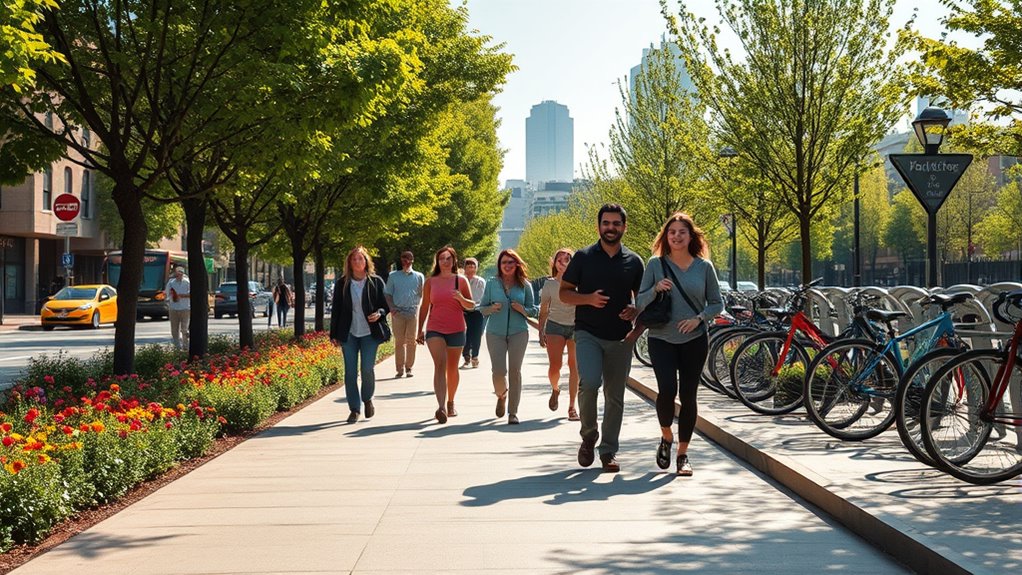
Walking stands out as the most eco-friendly transportation option available. By choosing to walk, you not only reduce your carbon footprint but also contribute to cleaner air and a healthier planet.
It's a simple yet powerful way to cut down on emissions that come from vehicles. Plus, walking keeps you active and can improve your overall well-being.
You'll discover that it's a great way to explore your surroundings, find new routes, and connect with your community.
Whether you're heading to work, school, or a local café, every step counts. So put on your comfortable shoes, enjoy the fresh air, and embrace walking as your primary mode of transportation.
It's a small change that makes a big difference!
E-Scooters: Quick and Convenient Travel

E-scooters offer a quick and convenient way to navigate urban landscapes. With just a smartphone app, you can locate and unlock an e-scooter nearby, getting you on your way in seconds.
They're perfect for short trips, helping you avoid traffic and parking hassles. You can zip from your home to the office or a coffee shop without breaking a sweat.
Plus, e-scooters are eco-friendly, producing zero emissions while you ride. Just remember to follow local regulations and ride safely. Wearing a helmet is a smart choice, too.
Telecommuting: Working From Home as a Green Solution
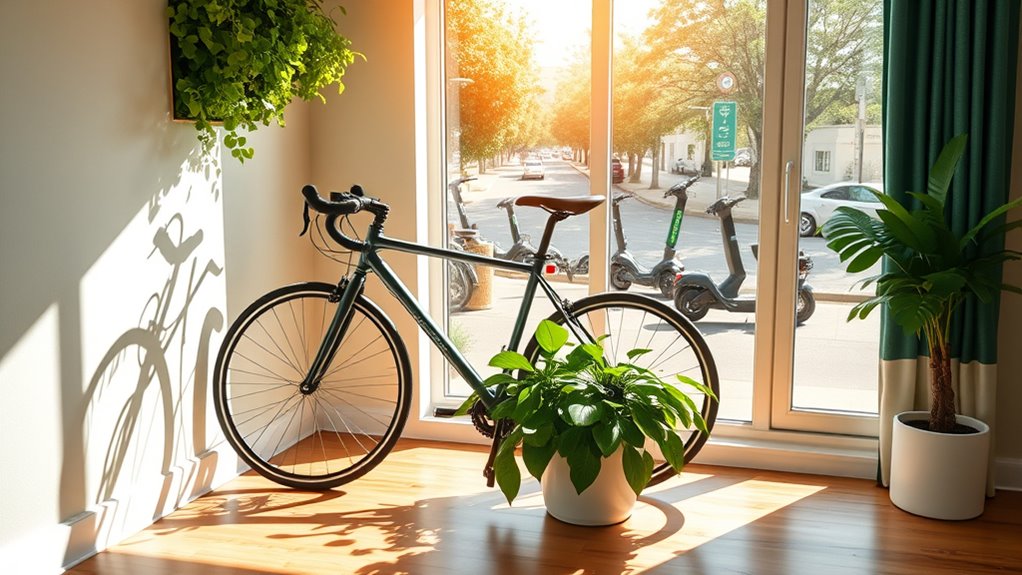
As you embrace telecommuting, you're not just enjoying the comforts of home; you're also making a positive impact on the environment. By working remotely, you reduce the need for daily commutes, which cuts down on traffic congestion and lowers greenhouse gas emissions.
Embracing telecommuting not only enhances your comfort but also helps reduce traffic congestion and greenhouse gas emissions.
You'll also save energy by not using public transportation or personal vehicles.
Moreover, you might find that you can create a more sustainable workspace, using energy-efficient appliances and reducing paper waste. When you're at home, it's easier to recycle and implement eco-friendly habits.
Plus, your flexible schedule allows you to align work tasks with your energy peaks, making you more productive. In short, telecommuting is a simple yet effective way to contribute to a greener planet.
Hybrid and Electric Vehicles: Greening Your Drive
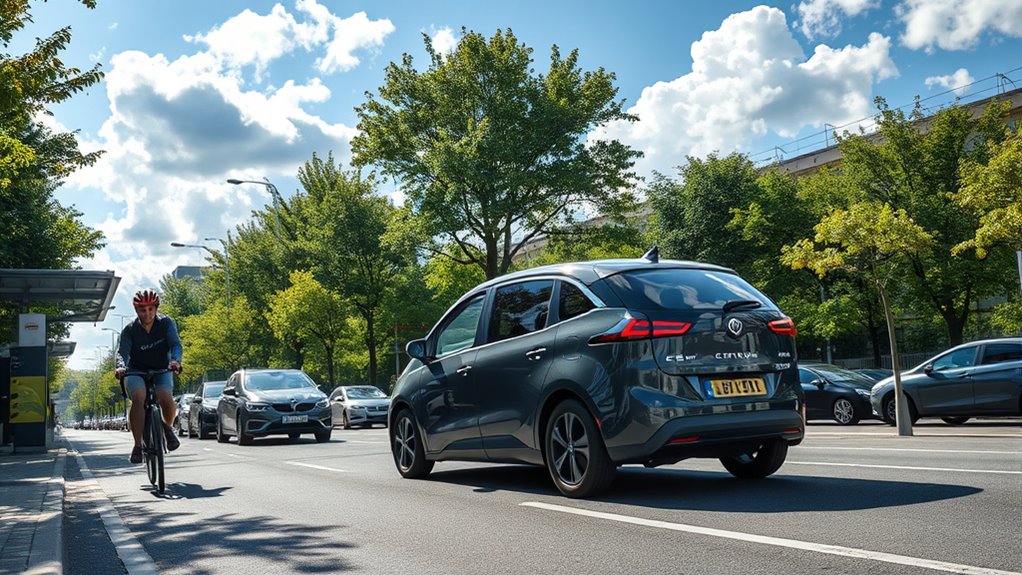
While many people still rely on traditional gas-powered cars, hybrid and electric vehicles (EVs) offer a greener alternative that can significantly reduce your carbon footprint.
By choosing a hybrid, you'll benefit from both an electric motor and a gasoline engine, improving fuel efficiency and lowering emissions.
With EVs, you completely eliminate tailpipe emissions, making them an excellent choice for a sustainable commute.
Charging infrastructure is expanding, and many models boast impressive ranges, making it easier than ever to go electric.
Plus, federal and state incentives can help offset your initial investment.
By making the switch, you're not just saving money on gas; you're also contributing to a cleaner environment for future generations.
Greening your drive has never been more accessible.
Bike Sharing Programs: Accessible and Affordable
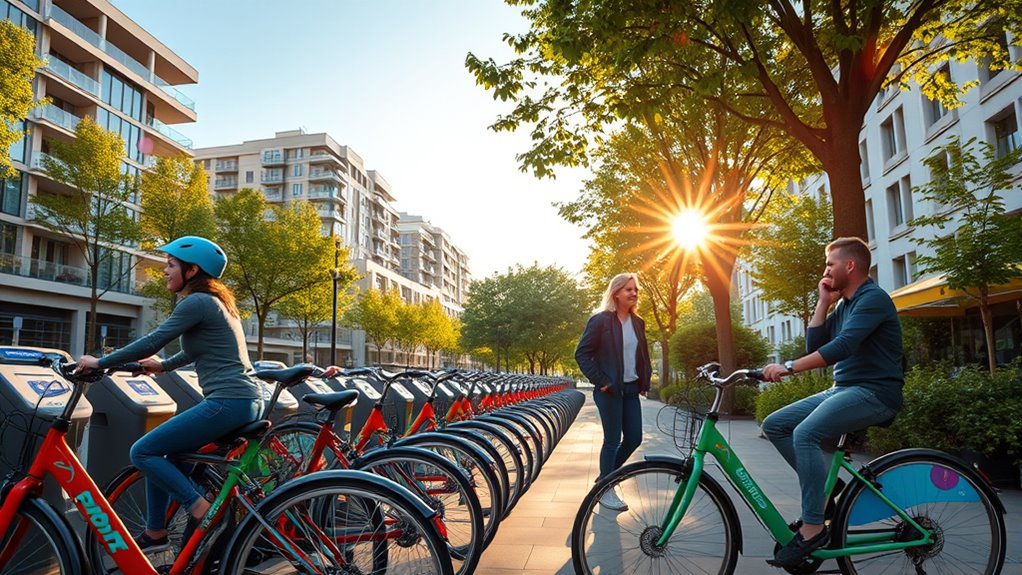
How can bike sharing programs transform your daily commute? By providing you with a convenient and affordable transportation option, these programs make it easy to navigate your city.
You can quickly grab a bike at a nearby station, skip traffic, and arrive at your destination faster. With flexible pricing plans, you don't have to invest in a personal bike, making cycling accessible to everyone.
You'll also enjoy the health benefits of biking while reducing your carbon footprint. Plus, bike sharing encourages a sense of community as you interact with fellow cyclists.
Green Car Rentals: Sustainable Alternatives for Short Trips
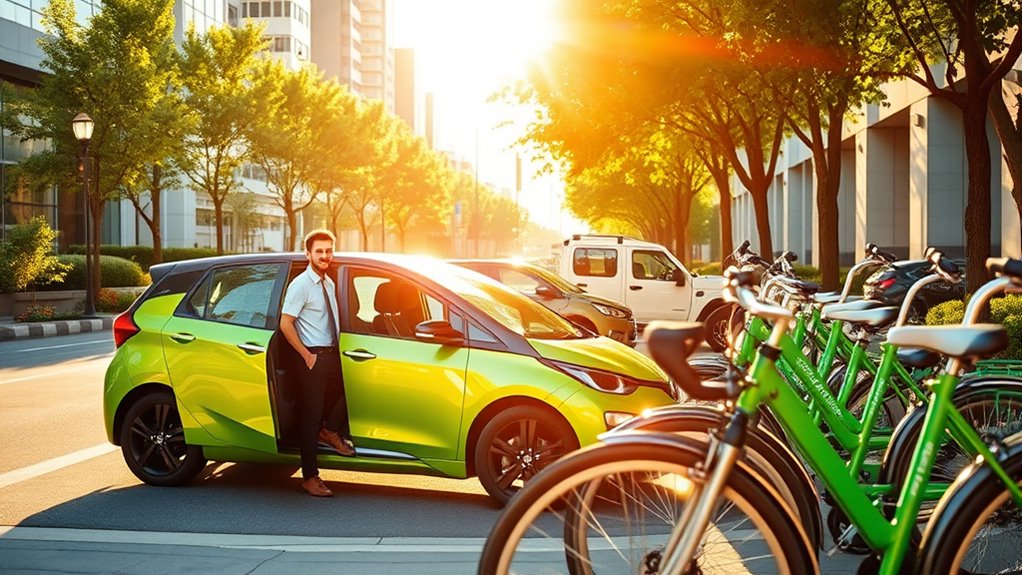
If you're looking for a sustainable way to get around for short trips, green car rentals offer an excellent solution.
These eco-friendly vehicles, often powered by electricity or hybrid technology, minimize your carbon footprint while providing convenience. Companies like Zipcar and Turo allow you to rent a car on-demand, so you're not tied down to a single vehicle.
Eco-friendly vehicles powered by electricity or hybrid technology reduce your carbon footprint while offering the convenience of on-demand rentals.
You can easily pick up a car when you need it and return it when you're done, making it perfect for quick errands or weekend getaways.
Plus, many rental services prioritize sustainability by maintaining and promoting fuel-efficient models.
Frequently Asked Questions
What Are the Environmental Benefits of Using Public Transportation?
Using public transportation has significant environmental benefits.
You reduce greenhouse gas emissions by taking the bus or train instead of driving alone. It also decreases air pollution, leading to cleaner, healthier cities.
Plus, public transit often uses less energy per passenger compared to personal vehicles. You'll help conserve natural resources and reduce traffic congestion, making your community more livable.
How Can I Find Local Bike-Sharing Programs?
Biking brings boundless benefits!
To find local bike-sharing programs, start by searching online for your city's transportation website. You can also download bike-sharing apps that list available programs nearby.
Local community boards or social media groups often share updates on bike-sharing initiatives, too.
Don't forget to check with local bike shops; they might've insider info on the best options.
Get ready to pedal your way to convenience and fun!
Are Electric Scooters Safe for Commuting?
Electric scooters can be a safe option for commuting if you follow some basic guidelines.
Always wear a helmet, stay aware of your surroundings, and obey traffic laws. Choose well-maintained scooters and ride in designated lanes when possible.
It's important to practice defensive riding, anticipating the actions of pedestrians and vehicles. If you're cautious and responsible, you'll likely enjoy a smooth and safe ride while using an electric scooter for your daily travels.
What Is the Cost Comparison Between Public Transport and Driving?
When you weigh the cost of driving against public transport, it's like comparing apples to oranges.
Driving involves fuel, maintenance, insurance, and parking fees that can quickly add up. In contrast, public transport typically offers a flat fare, making budgeting easier.
Depending on your location, you might find public transport significantly cheaper, allowing you to save money while reducing stress.
How Do I Maintain an Electric Bike for Longevity?
To maintain your electric bike for longevity, keep the battery charged but avoid overcharging it.
Regularly check the tire pressure and ensure they're properly inflated.
Clean the bike frequently to prevent dirt buildup, especially on the chain and gears.
Inspect the brakes and cables; replace any frayed parts immediately.
Finally, store your bike in a dry place to protect it from the elements.
Following these tips will help you enjoy a longer-lasting ride.
Conclusion
As you explore these sustainable transportation options, you might find that your choices ripple through your community. Imagine hopping on an electric bike one day, only to bump into a neighbor who's also reducing their carbon footprint. By embracing public transportation or carpooling, you're not just easing your commute; you're inspiring others to join in. Every small step counts, and together, you're creating a cleaner, greener future—one ride, one walk, and one shared journey at a time.









